
1
June 21, 1935 Acme Newsphoto. An early and iconic image of Louis, it has appeared in many books on boxing history.
| 
2
1935 Detroit Free Press: This premium was issued in the summer of 1935 and can be pinned down to a precise week of issue by advertising from the era.
| 
3
1935 Brown & Bigelow Joe Louis premium. B & B issued a number of Louis related pieces. The first two are my personal favorite Louis items. They are roughly a foot square, on cardboard, and sometimes are found with advertising specially printed on them.
| 
4
A variation with a caption. Also 1935.
| 
5
1935 Pattreiouex Joe Louis. Widely understood to be his first insert card.
| 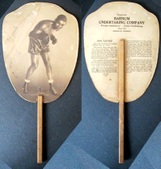
6
Brown & Bigelow also made fans using the Louis artwork, and sold them to various businesses for use as promotional products.
| 
7
|

8
| 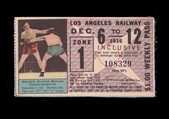
9
This is a December 1936 light rail ticket from Los Angeles depicting Louis and advertising the Golden Gloves tournament. Louis fought in Los Angeles in 1935.
| 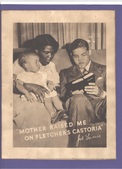
10
In 1935 Louis started working as a pitchman for Fletcher's Castoria, a laxative. This premium is ca. 1935-36 and is one the earliest Louis endorsement pieces I've seen
| 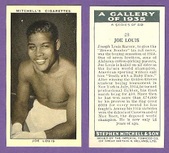
11
1936 Mitchell's
| 
12
| 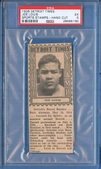
13
| 
14
|

15
An interesting piece circa 1937 made by an Oakland photogravure artist purportedly for a Louis appearance.
| 
16
One of the things that intrigues me is that an item like this survives all these years. This mailer was intended to be hung on doorknobs of newsstands to solicit sales of a newspaper special on the fight. Someone saved this circular all these years...fascinating, no?
| 
17
1938 [G.S. series] Ardath
| 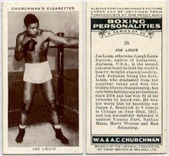
18
1938 Churchman's Joe Louis
| 
19
How freakin' cool this is! A betting slip from Louis-Schmeling II. It gives the bettor a chance at a specified outcome. BTW, there was no commission--the seal is a fraud. Betting on the match was entirely illegal.
| 
20
| 
21
|

22
| 
23
| 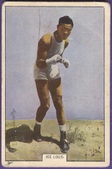
24
| 
25
| 
26
| 
27
| 
28
|

29
| 
30
| 
31
| 
32
| 
33
| 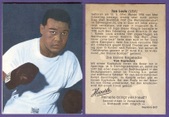
34
| 
35
|

36
| 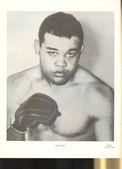
37
| 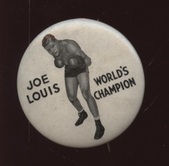
38
| 
39
| 
40
| 
41
| 
42
|

43
| 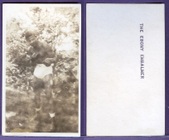
44
| 
45
| 
46
1930s Lucky Heart Co. Joe Louis premium.
| 
47
| 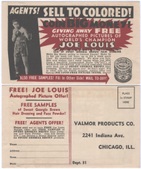
48
Circa 1937 advertising piece for cosmetics products using Joe Louis photos as a promotional aid.
| 
49
|

50
Advertisement for Lucky Heart Co. offering the Louis premium, from The Chicago Defender newspaper on June 5, 1937. Thanks to collector Arthur Rich for his research in finding this ad.
| 
51
One of a series of Joe Louis cards issued by Cincinnati manufacturer Orcajo.
| 
52
Two more of the same. Variations are known of the card of Joe and his wife, and non-Orcajo cards with the boxing pose also are known.
| 
53
Joe Louis visited Camp Beale during WWII and the California-based military installation issued a series of postcards to commemorate the visit. This one shows him with Sugar Ray Robinson. I have seen four different; there are apparently at least 11 since all are numbered.
| 
54
Another Camp Beale Louis
| 
55
And another.
| 
56
1950s giant sized PC of Joe Louis from the Moulin Rouge in Las Vegas. The first integrated casino, it lasted less than a year, accounting for the rarity of the PC.
|

57
A very tough die-cut Joe Louis restaurant PC from the 1950s.
| 
58
| 
59
| 
60
| 
61
| 
62
| 
63
|

64
| 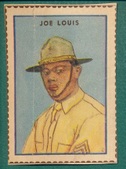
65
1942 Chicago Tribune Joe Louis, from a set of 70 WWII related strip cards issued in the newspaper with corresponding album.
| 
66
Coney Island Louis and Johnson. The pictures in the set were sourced from a variety of other issues and publicity photos.
| 
67
1948 Leaf Joe Louis. Printing quality is the biggest condition concern with 1948 Leaf cards. The card stock itself is fairly thick and holds up well, but the printing can vary from atrocious to breathtakingly nice. Front image registration is the single worst problem with the set. The set was printed in three passes -- black, red and blue – and relatively few of the cards actually align perfectly for all three phases. When the printing lines up exactly, the result is a crisp, sharp image and a very nice card indeed, but if any phase misses the mark by even a millimeter, the entire image is thrown off. Many collectors of this issue will sacrifice corner sharpness or centering to get a properly printed card. The card fronts also suffer from inking irregularities.
| 
68
Joe Louis made after his retirement as the date "1946-" has been removed from the card.
| 
69
In 1935 Louis started working as a pitchman for Fletcher's Castoria, a laxative. This premium is ca. 1935-36 and is one the earliest Louis endorsement pieces I've seen
| 
70
Joe Louis Wittone premium.
|

71
A very early premium for a 'snake oil' called Wittone. It is the size of a snapshot and is photographic. There are other premiums that resemble postcards.
| 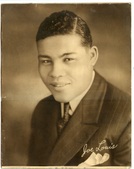
72
Another Wittone premium, this one much larger, with the ad cut off the bottom. You can just make out the top of the "TONE".
| 
73
Same image as the Wittone, but this one for Murray's hair pomade. Over a foot square and very damaged from framing but the only one I've ever seen.
| 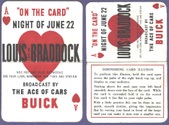
74
| 
75
A handbill for a Joe Louis fight film.
| 
76
This fantastic premium is a full newspaper page in size but printed on glossier paper with a blank back, for insertion into several papers that served the black community in the 1930s.
| 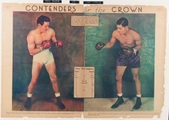
77
A newspaper premium before the Baer-Louis fight.
|

78
A Joe Louis printed pin-up that is a full page in a Life magazine.
| 
79
Don't know the ID of the issuer of this Louis piece.
| 
80
A blank-backed Louis premium from the 1930s.
| 
81
In the late 1940s Louis lent his name to a ring novelty item. This premium/advertising piece is from that endeavor.
| 
82
Issued in conjunction with a French-Canadian radio show at various times from 1943-47, the Parade Sportive issue is known for its hockey cards but there were boxers issued as well. The premiums are usually blank backed, paper stock. Sizes vary between series.
| 
83
Ticket envelopes and correspondence envelopes were commonly made for fights.
| 
84
|

85
| 
86
| 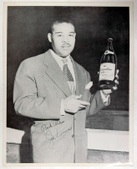
87
Joe Louis shilling for Canadian Ace beer. The company was long a front for organized crime and was trying to go legit when this was issued in the 1950s.
| 
88
1950s Joe Louis Milk Co. premium. PC sized.
| 
89
1950s Joe Louis Milk Co. premium. PC sized.
| 
90
A cut from a Joe Louis broadside or other promotional item.
| 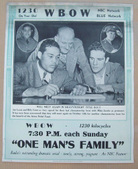
91
|

92
| 
93
| 
94
| 
95
| 
96
| 
97
| 
98
|

99
1946 newspaper premium for the Louis-Conn II bout.
| 
100
1930s press photo of Joe Louis and Hank Armstrong. Louis had his own baseball team for exhibitions.
| 
101
| 
102
| 
103
| 
104
| 
105
|

106
| 
107
| 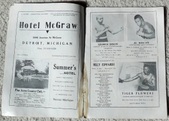
108
| 
109
| 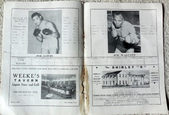
110
| 
111
| 
112
|

113
| 
114
| 
115
| 
116
| 
117
| 
118
1938 NX5 Joe Louis. Issued in Manila in 1938.
| 
119
1938 Churchman's Joe Louis
|
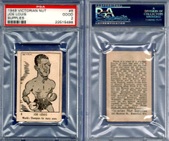
120
| 
121
| 
122
| 
123
| 
124
| 
125
| 
126
|

127
| 
128
This is a known secretarial autograph. Not signed by Louis.
| 
129
| 
130
| 
131
| 
132
| 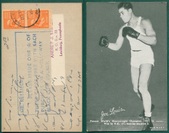
133
|

134
| 
135
| 
136
| 
137
| 
138
| 
139
| 
140
|

141
| 
142
| 
143
| 
144
| 
145
| 
146
| |